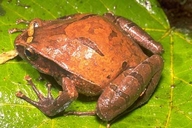|
Description
One of the world’s largest microhylids, F 55-63 mm, M up to 100 mm. Tympanum distinct, about 1/2 of eye diameter. Fingertips moderately enlarged. Tibiotarsal articulation reaches at least the eye. Finger 4 longer than finger 2. Skin on the back smooth. Back light brown, sometimes with a darker marking between the eyes, a darker brown inversed V-shaped marking and a pair of black spots in the inguinal region (Glaw and Vences 2007).
Similar species: Most other microhylids are smaller. Platypelis grandis has granular skin and larger finger discs (Glaw and Vences 2007).
Distribution and Habitat
Country distribution from AmphibiaWeb's database: Madagascar
Species found in Ambana, Ambatambe, Ambatovaky, Ampasimanolotra, Ampasy, An’Ala, Andasibe, Andohahela, Andringitra (Iantara river, Volotsangana river), Ankopakopaka forest, Antsihanaka, Chaines Anosyennes, Ivohibe, Mandraka, Mandriandry forest, Marotreho forest, Ranomafana (Maharira forest, Ranomena, Vatoharanana, Vohiparara), Tsararano (Glaw and Vences 2007) at 400-1100 m asl (Nussbaum et. al 2008).Life History, Abundance, Activity, and Special Behaviors
Habits: Under fallen tree trunks or on the forest floor. A calling male was found in a tree hole at a height of about 50 cm, indicating some kind of climbing behaviour in this species. Large eggs were found in tree holes, often close to the ground. Eggs probably belonging to this species were regurgitated by a male of the snake Liopholidophis rhadinaea. The stomach of a dissected specimen contained two scorpions and one stick-insect (Glaw and Vences 2007).
Calls: Reminds the barking of a small dog and consists of single melodious notes, repeated after regular intervals (Glaw and Vences 2007).
Trends and Threats
Species is listed as least concern in view of its wide distribution, presumed large population, and because it is unlikely to be declining fast enough to qualify for listing in a more threatened category (Nussbaum et. al 2008).
It occurs in many protected areas. However, its forest habitat is receding due to subsistence agriculture, timber extraction, charcoal manufacture, and invasive spread of eucalyptus, livestock grazing and expanding human settlements (Nussbaum et. al 2008). Possible reasons for amphibian decline General habitat alteration and loss
Habitat modification from deforestation, or logging related activities
Intensified agriculture or grazing
Urbanization
Comments
Taken with permission from Glaw and Vences (2007) and Nussbaum et. al (2008).
References
Glaw, F., and Vences, M. (2007). Field Guide to the Amphibians and Reptiles of Madagascar. Third Edition. Vences and Glaw Verlag, Köln.
Nussbaum, R., Cadle, J., and Vallan, D. (2008). Plethodontohyla inguinalis. In: IUCN 2008. 2008 IUCN Red List of Threatened Species. www.iucnredlist.org. Downloaded on 21 April 2009.
Originally submitted by: Miguel Vences and Frank Glaw (first posted 2001-10-23)
Edited by: Catherine Aguilar (2010-07-19)Species Account Citation: AmphibiaWeb 2010 Plethodontohyla inguinalis <https://amphibiaweb.org/species/2351> University of California, Berkeley, CA, USA. Accessed Jun 16, 2025.
Feedback or comments about this page.
Citation: AmphibiaWeb. 2025. <https://amphibiaweb.org> University of California, Berkeley, CA, USA. Accessed 16 Jun 2025.
AmphibiaWeb's policy on data use.
|
